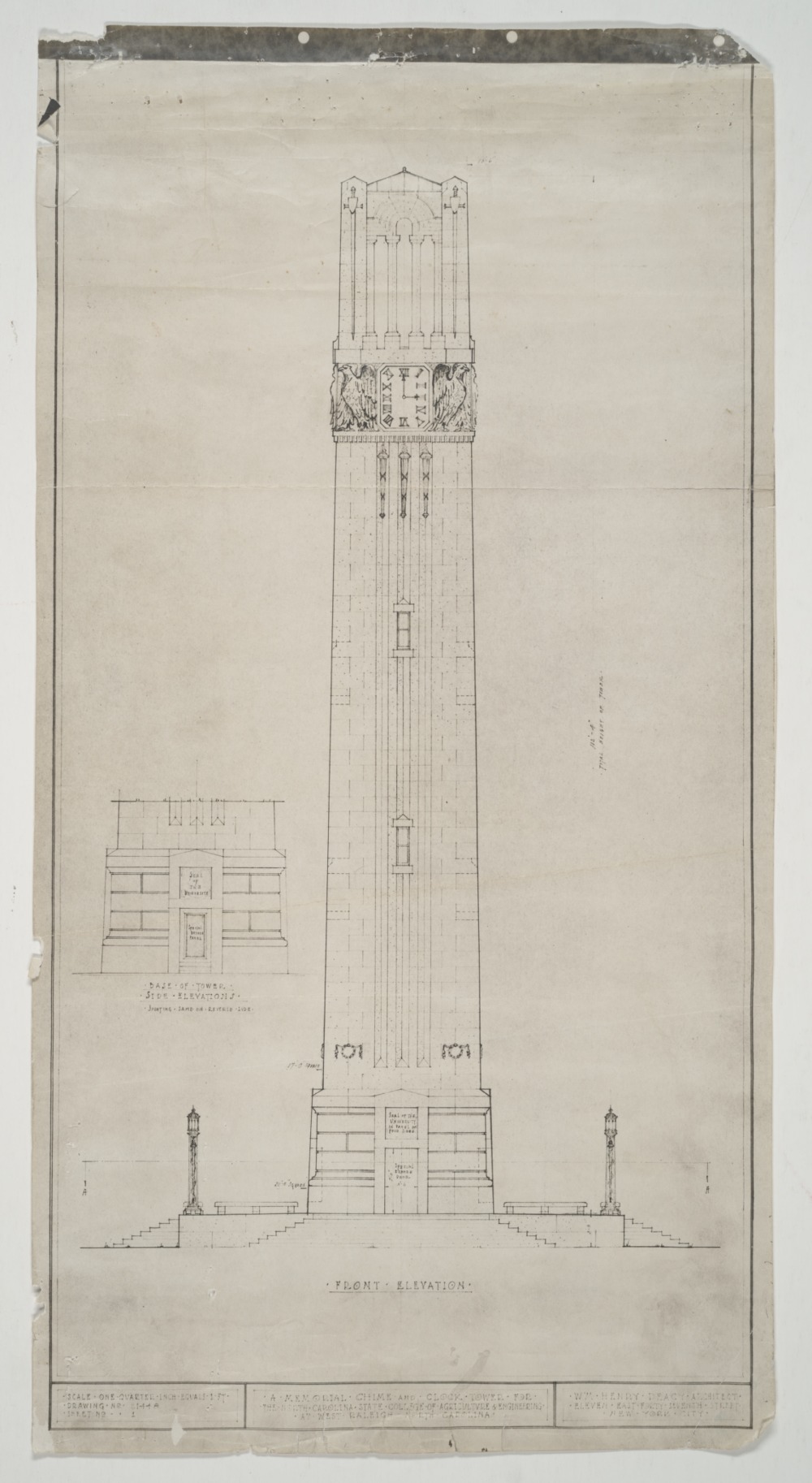
"To Perpetuate the Names of Heroes"

In commemoration of the 100th anniversary of U.S. participation in World War I, Special Collections continues its examination of the impact that the war had on NC State students, faculty, and campus with a look at the beginning of the campaign to build a proper memorial to those students who perished in the war. That memorial, of course, became the Memorial Bell Tower, one of NC State's most recognizeable symbols.
In September of 1918 (before the war had even ended) E.B. Owen, secretary/treasurer of the General Alumni Association, introduced the idea of memorials in Alumni News. He says, "We must be looking forward to the establishment of suitable memorials to the men who have fallen and who are to fall in the world war in which more than a thousand of our number are engaged." Here, Owen was positioning the Alumni Association as the economic driver behind the future memorial. He perhaps inspired Vance Sykes, who is credited traditionally as starting the campaign to build a memorial with his call to arms printed in the Alumni News of November 1, 1918.
As evidenced by the letter, Sykes was saddened and motivated by the death of Frank Thompson, class of 1909. Thompson was a very popular and valiant athlete during his days at State College (now NC State), and his death sent shock waves through the alumni. Sykes must have been more friendly with Thompson than most, as he is seated next to him in this image of the 1907 football team:
Following Sykes' letter, many more poured in, enthusiastically supporting a fundraising campaign to build a permanent structure to immortalize the fallen. As alumnus George Syme succinctly puts it, "It is as little as we could do to commemorate in stone what they have made possible by their very life blood."
Once the decision was made to build a memorial, the fundraising campaign began in earnest. A Memorial Committee was established, and it sent out hundreds of mailers soliciting donations. Prominent alumni were contacted for their donations and their connections. The Alumni News printed reminders with every issue and included a list of those who had donated to the cause (which they called subscription to Memorial to Fallen State College Men). A network of county chairmen was established for the effort.
Once the campaign was in full swing, donors began declaring their chosen form for the structure. Suggestions included a flagstaff, a granite shaft with bronze tablets, renovations to the hospital, a clock tower, a student loan fund, a building, and a gateway. In the Alumni News of March 1, 1919, R.E. Snowden and W.L. Craven write of the desire to build "something durable - something that will stand like the monuments of the Pharoahs, for centuries; for the memorial will be for the benefit of those who follow us, rather than for ourselves." Some, like W.W. Finley, were very specific in their wishes for the form of the memorial: "Build a 'hostess house' with wide verandas, with 28 columns, bearing similar bronze tablets recording name, rank, and service data." In the end, the Memorial Committee unanimously made the final decision, settling on a "campanile, that is, a tower with clock and chimes." This decision was reported to the General Alumni Association, which then adopted the design for a memorial clock tower in May of 1920.
 Of course, it would be a long struggle to complete the Bell Tower, amid spiraling construction costs, difficulties raising funds, and then the advent of the Great Depression. Only in the near future will the Bell Tower be totally finished, complete with real bells that have been missing for decades. It is apt therefore to look back at the origins of the Bell Tower and the campaign to build it, sparked partly by a friendship between two football players.
Of course, it would be a long struggle to complete the Bell Tower, amid spiraling construction costs, difficulties raising funds, and then the advent of the Great Depression. Only in the near future will the Bell Tower be totally finished, complete with real bells that have been missing for decades. It is apt therefore to look back at the origins of the Bell Tower and the campaign to build it, sparked partly by a friendship between two football players.
All research for this post was conducted using recently digitized Alumni publications. For more resources regarding university history and many other topics, search our digitized collections. Explore these posts for other topics in our World War I series:
Robert Opie Lindsay, North Carolina's Only Flying Ace
From Somewhere in France: Letters from Alumni in World War I
Fred Barnett Wheeler: Alumnus, Soldier, Councilman, Mayor
Agricultural Patriotism During World War I
Lieutenant James Malcolmson Rumple
Recipes from World War I (Part 1) - Meatless
Recipes from World War I (Part 2) - Wheatless
Recipes from World War I (Part 3) - Sweetless (Sugarless)
Camp Polk: Tanks Come to Raleigh
The Bell Tower Names: Alumni Who Gave Their Lives in World War I

